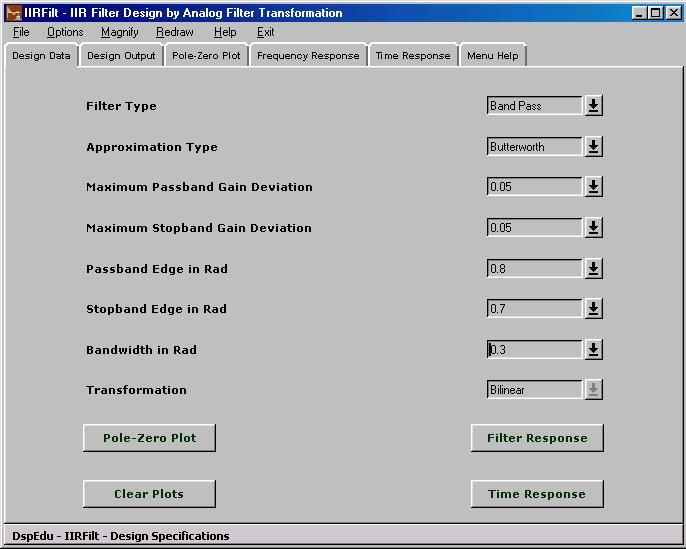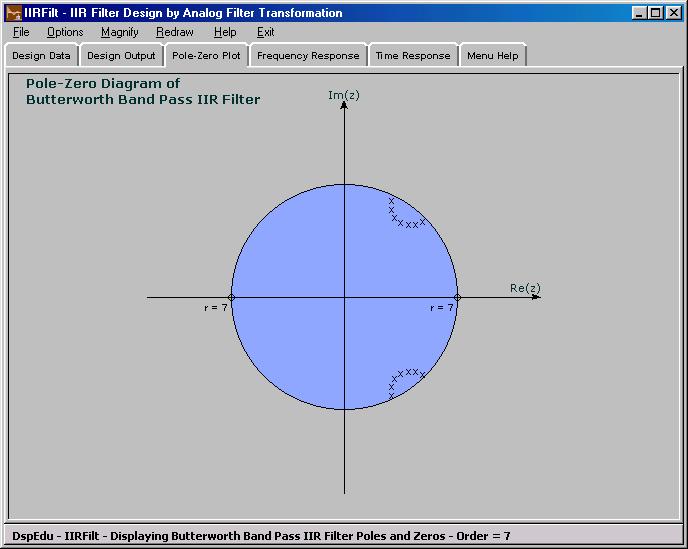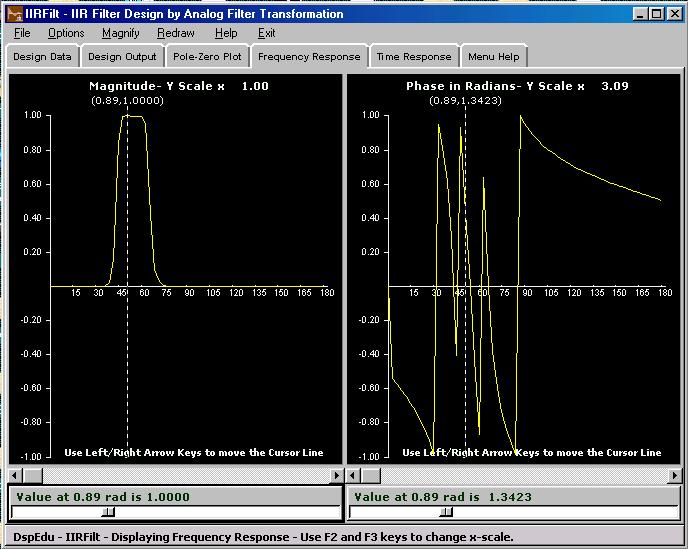DspEdu 2.1 is an Educational Software Package in DSP with Six Modules Covering 1. Linear Convolution of Two Finite Duration Sequences 2. Circular Convolution of Two Sequences 3. Linear Convolution from Circular Convolution 4. FFT and Sampling of Fourier Transforms 5. Spectral Analysis of Periodic Continuous Waveforms by FFT 6. FIR Filter Design by Windowing 7. IIR Filter Design by Analog to Discrete Transformation 8. Discrete-Time Transfer Function Pole-Zero Analysis.
This Site also contains a growing collection of Technical Articles written by Suresh Kumar K.S on topics in Electrical Engineering.
|
1. What does it do ? This module implements the design of IIR Filters by Analog Filter Transformation . Three approximation functions - Butterworth , Chebyshev I and Chebyshev II - are supported for Low Pass , High Pass , Band Pass and Band Elimination Type Filters. Filter Impulse Response Sequence ,Filter Impulse Response Sequence and Frequency Response of the Filter are plotted with Slider Scale value read-out feature.The pole-zero in z-plane will also be displayed.Only Bilinear Transformation is currently supported. The filter design data can be saved into *.iir file in the default project directory. The frequency response data output also can be stored in *.txt file and the plots can be saved in *.ps (Postscript Format) files in the default project directory. 2. Tab Windows
2.1 'Design Data' Window Contains pulldown boxes for selecting or entering 8 design parameters. The filter specifications are in discrete domain and the passband and stopband edges are in radians.The allowed maximum gain deviation in passband and stopband are to be entered in their real value and not in dB. The Bandwidth Parameter is used only in Bandpass and Band Elimination Designs. In that case the product of passband edges and stop band edges are taken to be equal and the values entered in the relevant boxes are taken to be the values pertaining to the left side of frequency response with respect to center of the band. 2.2 'Design Output' Window Shows the design specifications , the calculated prewarped frequencies , order of the filter and discrete-domain poles and zeros with their multiplicity. The window content can be copied to clipboard by right clicking and invoking 'select all' under 'Edit' menu followed by 'Copy' under the same menu. 2.3'Pole-Zero Plot' Window Shows the Pole-Zero plot in the z-domain with respect to unit circle.The multiplicity of poles and zeros will also be displayed.
2.4 'Frequency Response' Window Shows the one-sided frequency response plots (when the window is raised frequency response at 1 degree interval over 0 to 180 degrees on the unit circle is calculated and the plots are updated if necessary) of the design currently on display in the 'Design Outputs' window. Shows Magnitude and Angle.
Two slider scales appearing at the bottom of the plots allow readout of index and spectral data at that index. Magnitude spectra will have even symmetry and Angle spectra will have odd symmetry.
2.5 'Time Response' Window
Shows the Impulse and Step Responses of the designed filter. The plot window comes with a slider scale which can be used to recalculate and display the waveforms with more number of points in them. The default display length is 64 points. 2.6 'Menu Help' Window Raises the window and puts a brief help on the menu items in it. 3. Menubar Items 3.1 File Menu 3.1.1 Load Saved Project Load a Sampled & Windowed Sequence and the Window Sequence used by opening a *.iir file saved in an earlier session.The default directory will be '/Projects/iirfilter' 3.1.2 Save Project 3.1.3 Save Transfer Function
3.1.3 Frequency Response Outputs
3.1.5 Save Plots 3.2 Options 3.2.1 Display Color Options Normal Plot Color - The color used to draw x1(n) , x2(n) and convolution outputs.Second Plot Color - The color used to draw a second plot in the same plot area. Background Color - The color used as background for all the four plot areas. These three options bring up standard windows color selection dialog and changes take immediate effect Schemes - Three color schemes in addition to default scheme are provided.Changes take immediate effect. 3.2.2 Display Mode Data Points - The plots will be line plots , a line representing the data value.Data Envelope - A piece-wise linear curve joining the data points will be shown. Changing this option comes into effect immediately in the existing plots. 3.2.3 Set Frequency Points Brings up a new window. The number of points at which frequency response is to be evaluated can be set in this window. The default is 60.3.2.4 Set Time Response Points Brings up a new window. The number of points in impulse and step responses can be set in this window. The default is 64.3.3 Magnify Magnify the x-axis by various fixed factors. F2 key will expand the x-axis and F3 key will compress it.However this menu provides fixed scale factors for convenience.3.4 Redraw Re-scale all the four plot areas and redraw all the plots - needed after a resize of the main window.3.5 Help -This page.3.6 Exit 4. Restrictions in the Evaluation Version The Module can be run only 15 times and each session will last only for 10 minutes. There are no feature limits. 5. Author Suresh Kumar K.SDepartment of Electrical Engineering National Institute of Technology,Calicut-673601,Kerala,India sureshks (at) nitc (dot) ac (dot) in 29th April 2004 Page Updated on 29th April 2004 |


